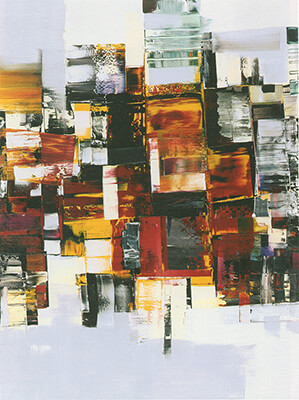Nola Zirin’s Urban Abstractions
By Barry Schwabsky
(essay for the exhibition catalog, Nola Zirin, New Paintings, April 28-May 30, 2000 at June Kelly Gallery, NYC)
Modern urban experience – and New York in particular – has long been a stimulus to and a subject of abstract painting. On the one hand, the Abstract Expressionists (at least until they started migrating out to the serenity of then-rural East Hampton) articulated something of the clamor and upheaval of city life. Clement Greenberg wrote of Jackson Pollock’s work, for instance, as “an attempt to cope with urban life,” and perhaps, in a formal parallel with city life, art that “may at first sight seem crowded and repetitious reveals on second sight an infinity of dramatic movement and variety,” as Greenberg put it.
An artist as different from the Abstract Expressionists as Piet Mondrian had been moved to express his sense of the city too after emigrating here, in his late “Boogie-Woogie” paintings. He saw urban life differently, finding a sort of rhythmic regularity rather than conflict beneath its verve and activity.
Nola Zirin readily acknowledges that the roots of her art are in Abstract Expressionism, citing the influence of Milton Resnick, one of her teachers at New York University, as well as of George McNeil (whom she recalls as one of Resnick’s constant reference points in those days), the Hans Hofmann-trained abstractionist who subsequently turned to a form of raw, playful figuration. Looking back at the romantic, atmospheric work Zirin was making just a few years ago, the connections to Abstract Expressionism are patent.
But Zirin’s work has changed, and the fluid, mercurial paint-handling that distinguished her work has now not disappeared, certainly, but has been submitted to a different kind of organizing principle: structure is no longer insinuated but emphasized. Many of the paintings (such as Wild Posting or City Shroud) are now based on loose grid structures – Mondrian’s constructivist tradition shaking hands with the echoes of Abstract Expressionism, as it were. A new complexity emerges. Each segment within a work like Will Posting could almost be seen as a small painting in itself, an active flow of blending or contrasting pigments that abruptly ends where it abuts its neighbor. A real tension emerges from the interaction of these semi-self-contained fragments.
Where the works in Zirin’s 1997 exhibition were filled with clear evocations of landscape, of nature, of open space, the new ones are dense, crowded and animated. There is a newfound sense of excitement and urgency. This is abstract painting with a distinctly urban tone.
Zirin is clearly working in cognizance of contemporary abstract painters like David Reed and David Row as well as of illustrious precursors, but her paintings always have a flavor that is particularly hers. She remains much more the “hands-on” improviser in comparison to some of her colleagues, who favor high artifice and a mediated appearance, and whose work tends to be characterized by a certain cool detachment.
What she does seem to share with such painters, however, is their fascination with photographic effects, but not so much as an evocation of technology as because a sense that the “instantaneity” of surface effects in a painting can give it an air of magic, of mystery – the feeling that there are apparitions at work. This is particularly evident in some of Zirin’s smaller, grisaille paintings (such as Phases) in which oval forms emerge from the grid. These paintings are, I suspect, the hushed “interiors,” corresponding to her more extroverted large-scale paintings which always preserve something of the energy (and sometimes chaos) of the street.
A persistent memory: when I walked into Zirin’s Brooklyn studio, having come to see the new paintings from which this exhibition has been selected, my ears were engaged almost as soon as my eyes. I was hearing two things at once: first, the cool insinuating sounds of a Miles Davis tune, though performed not by Davis but that soulful and innovative organic, Jimmy Smith; then, just below that, the incessant and semi-chaotic urban racket of a busy industrial New York. (More artist will turn off their music when you’re concentrating on their work but here, it was clear, the noise from outside would have been even more distractingly without being smoothed over by the music.)
And as I looked at the paintings to this dual accompaniment, I realized that these two kinds of vibration together formed the atmosphere of this studio, the invisible ethos to which Zirin’s paintings give visual form – the mechanized clash and clamor of industrial civilization merging with the fluidity, grace and spontaneity of jazz.
---
Barry Schwabsky is the author of The Widening Circle: Consequences of Modernism in Contemporary Art (Cambridge University Press, 1997). He writes regularly for Artforum and other publications, and is a Contributing Editor of Art On Paper and a member of the editorial board of Art/Text.
